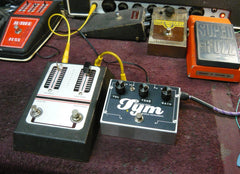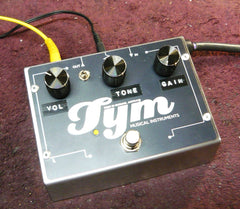I met Jason and the guys from Dead Meadow several years ago when Jason played an acoustic instore in my shop. I am a massive fan of Jason's solo album so I was very excited indeed.
At that stage I'd really only heard the first DM album and loved the tones on it and even though they'd been out here before, I'd never seen them live. I thought the album had prepared me for the distorted, fuzzy onslaught of seeing them live that night after the beautiful intimate acoustic set. I was wrong.
Jason's guitar tone was ............... nasty, obliterated fuzz with almost indiscernible edges and slabs of square-wave heaven. I remember being amazed at how heavily distorted parts of it were but without ever loosing definition and clarity. Jason's amazing technique and talent as a guitarist goes a big part way to making this almost impossible perfect storm work.
After the show we spoke about fuzz, effects, tones and fuzz and we parted ways with a "we should talk about a fuzz pedal" idea planted in us both.
Jason's a very busy guy and, well, I don't have a lot of spare time to chase ideas no matter how much I'm into them so the idea lay dormant for years. We spoke every so often and the idea of a "signature fuzz" was mentioned many times and several false starts were aborted due to lack of time on my part, and it never really got past a mutually agreed upon exciting idea stage.

Then Dead meadow re-issued their first album on vinyl so I ordered a bunch for the shop and when they arrived, I put one on the turntable and remembered what a great guitar tone that album has. It made me email Jason and say "are you still into that signature fuzz idea?"
Jason was excited. I was excited. The idea was on.
I asked Jason "OK, what type of fuzz are we thinking of here ?" and he sent me some audio files from around the first album and said "there's a solo on this song that I want" ........... He didn't remember what was used on the recordings so we had to start from there.
For those of you who make pedals you'll know that it's hard to work from "descriptions" 'cause what's in your head, and the way you describe it, can be completely different to the way I hear it, and describe it. This was a good starting point, although still quite daunting. The Fuzz Munchkin was "easier" as I had an actual pedal to clone and play to compare. The Earthless fuzz was similar to this, although Izzy just gave me a "description from his crazy head". This was somewhere in between.
To me it sounded like a Superfuzz ......... kinda. Not a Big Muff, not a Fuzz Face. I went through all the "classics" ........... and started pulling out pedals from my collection that I use for reference. Nothings going to sound the same as a recording. There's too many variables. Mics, placement, amps, speakers, pedals, rooms, compression, capture, mixing, mastering not to mention the actual person playing the guitar etc etc. It's the reason I don't do online audio demos of anything I make.
I settled on the Ibanez Standard fuzz as being "close" in tone but not exactly what was in my head but I thought I'd start from there. It's a similar circuit to the Univox/Shen-ei Superfuzz but with a bit more "squall", a little bit more ........ unhinged in the top end ? I messed around for a few days with this circuit going backwards and forwards with ideas until I was pretty happy with what I had.
I emailed Jason and said it's ready to go and he needs to hear it to see where we need to go. It's easier to go FROM an actual fuzz to somewhere close (or not so close) than just from audio files so I told Jason to try it with his rig and tell me what needs to be done.
I got an email from Jason saying "You nailed that tone. It's amazing" which made me feel pretty good. It did need tweaking, which I knew would be the case. Jason sent me detailed descriptions and ideas like "the bass boost on is way too much bass and the bass boost off is way too little bass"' "I really want to get it so that the bass level of the fuzz remains close to what the amp is kicking out with the pedal off." and "I usually play with my amps pretty bass heavy in Dead Meadow so I don't think we'll need much of a bass boost at all but just a way to maintain that bass level. I've played a number of old school "buzzy" style fuzzes that have the opposite problem, they come across super bright and have an inherent bass cut." The good part was, the fuzz TONE was there, we just need to fine tune the settings.
This is a challenge I can rise to. Jason was always apologetic for the "trouble" but I actually enjoy this when I have the time. A bit of fine tuning on the bass response and a complete overhaul of the mid switch and I was pretty happy with it. It doesn't have anywhere near the bottom end of a Standard Fuzz (or a Superfuzz) but the bulk of the fuzz tone is similar.
I had also added an active tone control as I'm a big fan of some type of tone shaping in a fuzz. It's similar to a BM tone stack with less mid scoop in the standard setting a flat response in the mid setting. The bass switch changes the freq response IN the output section to some bass or less bass as per Jason's request. The gain control goes from lots to lots more. This ain't no subtle overdrive.
I settled on three different types of transistors through a 4 transistor circuit with two of them being NOS C945's like I use in my Superfuzz clone. I'm a big fan of these in the engine of this type of fuzz.
So, I shipped the second version over to Jason and he loved it. This was it.
We had discussed artwork and Jason said he'd like Steve, who plays bass in DM to do it, which is fine by me. Steve did up a killer Dead Meadow monster and my artwork guy, Tone from Guitarnerd "fitted" it to the pedal layout. I made another pedal with the new artwork and shipped this over to Jason for him and Steve to check out the "final" version. Jason said "The pedal arrived! First of all the artwork looks amazing! I dig the whitish metal you got for it. It looks so good!"
This was it then ................

